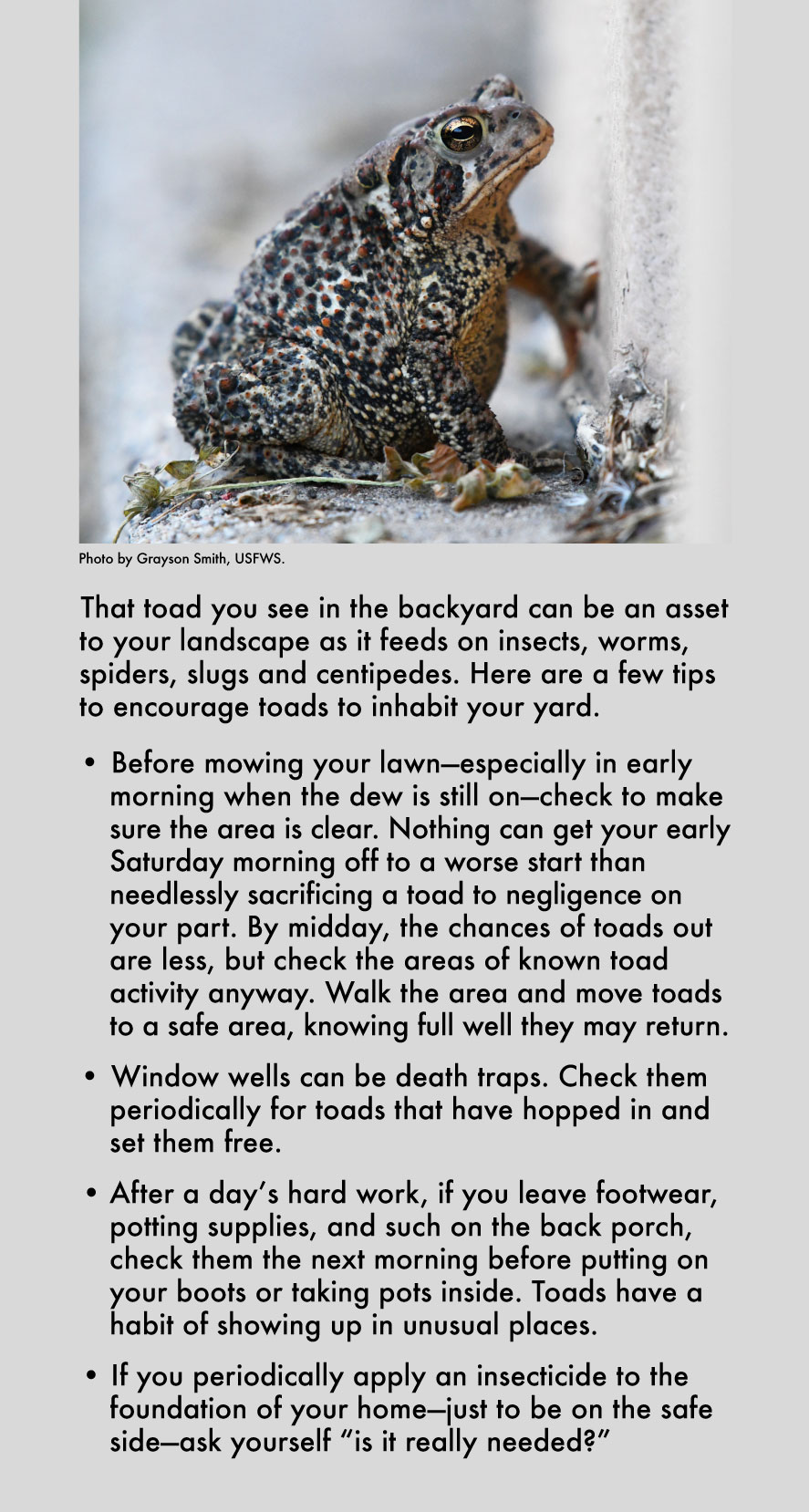
Photo by Michael R. Jeffords.



Photo by Michael R. Jeffords.
The American toad is an amphibian that could be living right next to you, and you may not even know it. These toads are common throughout most of Illinois and are found in a variety of habitats, including most wooded and grassland areas in both rural agricultural and residential urban areas—even in your own backyard.
The critical requirement for any of these habitats is that, during breeding season in April and May, water must be available for American toads to reproduce. A river, drainage ditch, backyard pool or retention pond will suffice.
Spring breeding season is something to behold. If you have ever frequented a backwater or oxbow lake along a river, the continuous, high-pitched whine or trill of males is unbelievable. You may think there are thousands upon thousands of males “courting” the females, but in reality, there are a lot less. The trill is deafening—all individual trills blending into a crescendo that doesn’t “quiesce.”

Once a female is found, the smaller male stops trilling and mounts her. The male hugs and squeezes the back of the female, inducing her to lay long strings of several thousand black eggs which he is in perfect position to fertilize. Fertilized eggs hatch in a week and become jet-black tadpoles. Tadpoles transform into toadlets in 40 days, ready to begin their journeys on dry land, sometimes en masse.
While on land, American toads can live under about any type of debris, including a firewood pile, unmown grass and ornamental plantings next to foundations. Moist areas, such as shaded sides of structures with leaky gutters, attract them; and they will even burrow in drier soil if moisture is nearby. They may even burrow into soil next to foundations. Aside from being a cooler place to hang out during the heat of summer, such microhabitats attract countless insects and earthworms, favorite fare for the American toad. Their summer burrows there are often used for winter hibernation. They dig backwards and deeper into these summer burrow, covering themselves with summer’s dirt. Toads are real homebodies.
Mostly nocturnal, sometimes American toads venture out to feed in daytime, during warm summer rains.

American toads (Anaxyrus americanus) are easy to differentiate from their close cousin the Fowler’s toad (Anaxyrus fowleri). American toads have one or two large warts on their back and substantial warts on their legs. The mottled body color ranges from brown, reddish-brown, to gray. Skin colors may change somewhat with changing habitats and temperatures. Mottling continues on the chest and belly. The American toad has a very pronounced cranial crest between its bulging eyes—much more than a Fowler’s toad, a species that it sometimes hybridizes with. The warts on Fowler’s toad are much less pronounced and its chest and belly are mostly white or gray.
If you have never experienced the “trill of a lifetime,” hike to some standing water or a backwater or oxbow lake between late April and early May. Pick a still, calm evening. Be immersed in the sounds of male American toads, trilling for the continuance of their species.
Consider as your nearest neighbor that toad you see on a regular basis along the foundation of your home or in the backyard. Females can become quite tame and may live for 20 years or more!
Robert J. Reber is an emeritus faculty member in the Department of Food Science and Human Nutrition of the University of Illinois at Urbana–Champaign. He has been a lifelong student of many aspects of the Natural World, including archaeology. Bob has served as a managing editor and author for publications such as The Illinois Steward magazine and the Illinois Master Naturalist Curriculum Guide.
Submit a question for the author